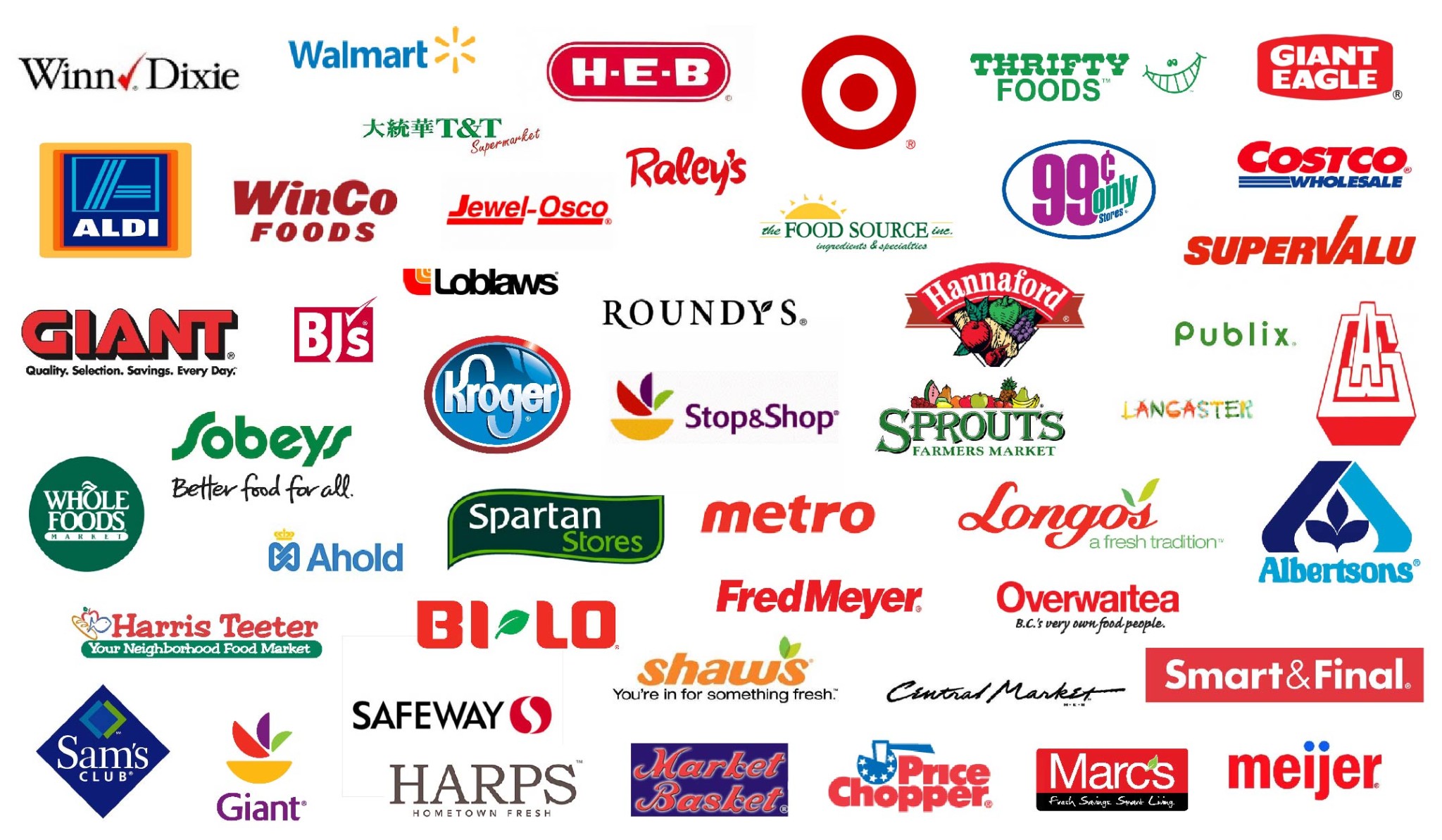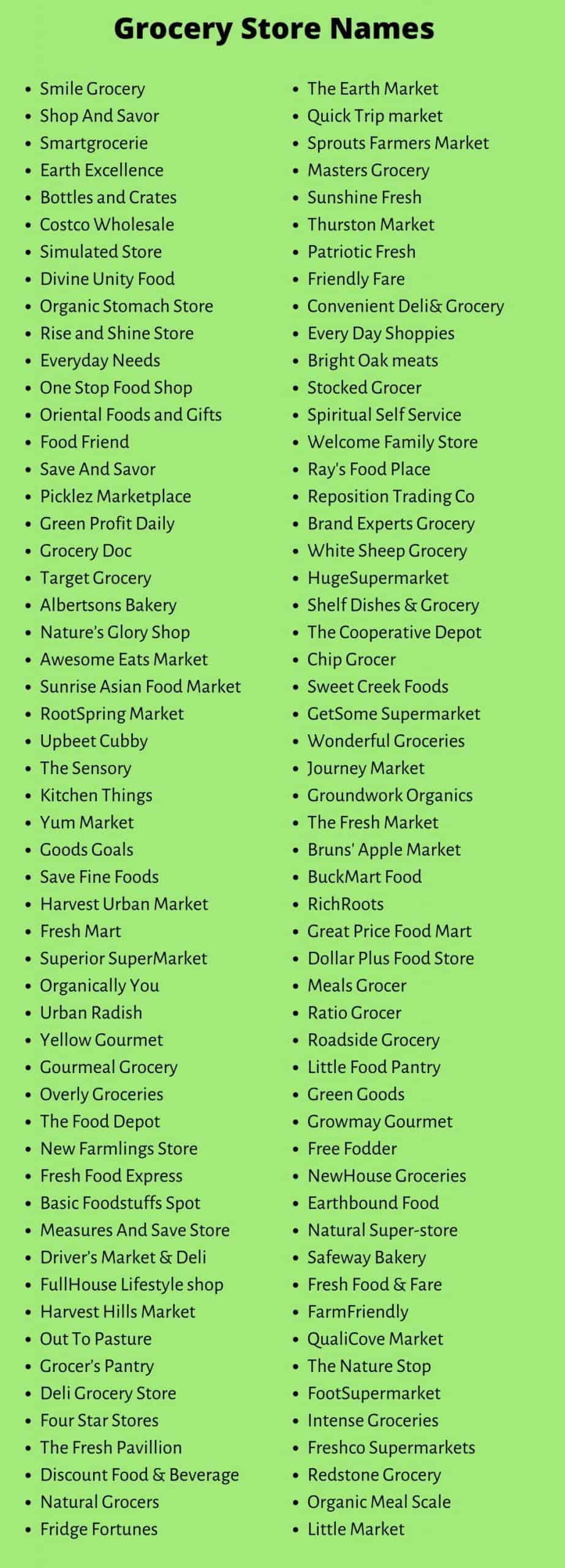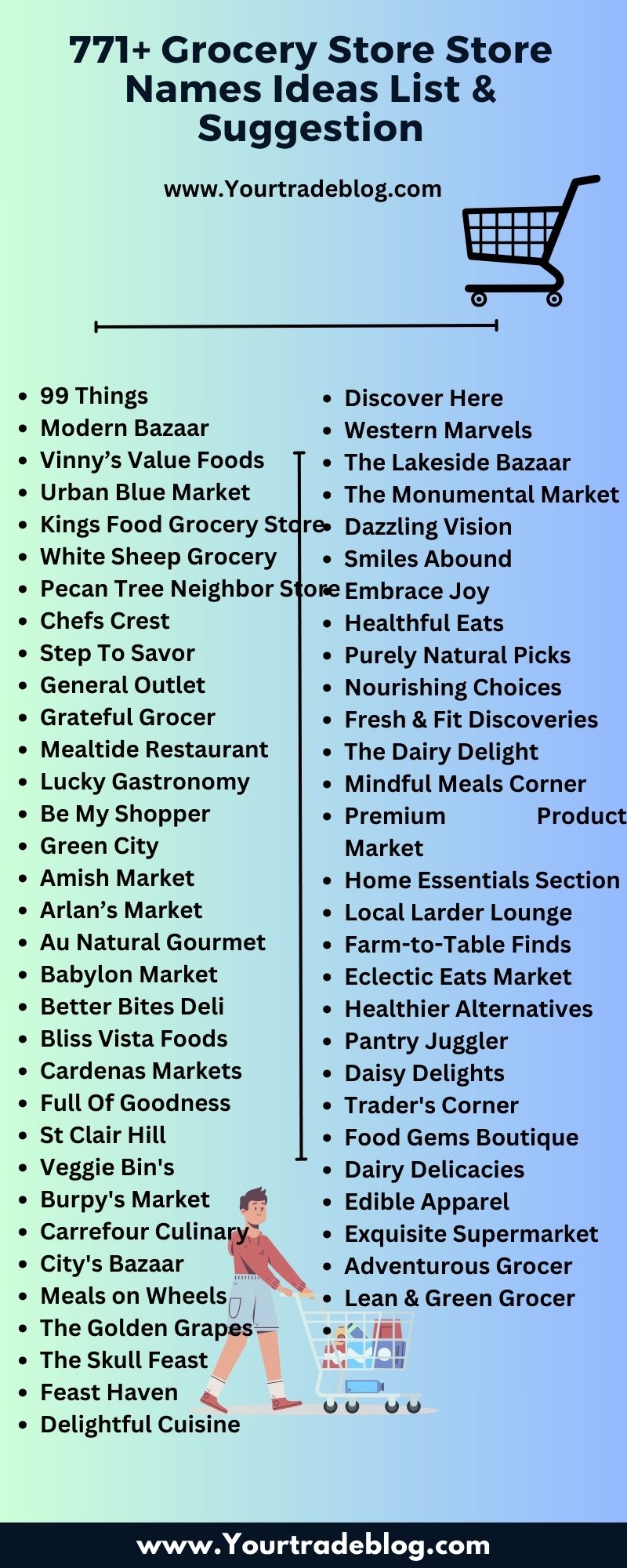Why a Great Name Matters for Your Grocery Business
A well-chosen name for a grocery store is crucial for its success. A great name can help a grocery store stand out in a competitive market, establish its brand identity, and create a lasting impression on customers. In fact, a study by the National Retail Federation found that a store’s name is one of the top factors that influence a customer’s decision to shop there. A good name can also make a grocery store more memorable, increasing the chances of customers returning and recommending the store to others.
When it comes to choosing the best name for a grocery store, it’s essential to consider the target audience and the store’s unique selling proposition (USP). A name that resonates with the target audience and reflects the store’s values and mission can help build trust and loyalty. For example, a grocery store that specializes in organic and natural products might choose a name that conveys its commitment to healthy living.
In addition to its impact on branding and customer perception, a great name can also influence a grocery store’s marketing efforts. A catchy and memorable name can make advertising and promotional materials more effective, increasing the store’s visibility and reach. Furthermore, a well-chosen name can help a grocery store establish a strong online presence, making it easier for customers to find and engage with the store.
Ultimately, choosing the best name for a grocery store requires careful consideration and creativity. By taking the time to brainstorm and research different options, grocery store owners can find a name that accurately reflects their brand and resonates with their target audience. With a great name, a grocery store can establish a strong foundation for success and build a loyal customer base.
How to Brainstorm a Memorable Name for Your Grocery Store
Brainstorming a memorable name for a grocery store requires creativity and a deep understanding of the target audience. One effective technique is to use word associations, where you combine two or more words that evoke a particular feeling or image. For example, “FreshMart” combines the words “fresh” and “mart” to create a name that conveys a sense of quality and convenience.
Another technique is to combine words that reflect the store’s values or mission. For instance, “GreenEarth Market” combines the words “green” and “earth” to create a name that conveys a commitment to sustainability and environmental responsibility. This type of name can help a grocery store stand out in a crowded market and appeal to customers who share similar values.
Creating acronyms is another effective way to brainstorm a memorable name for a grocery store. For example, “S.M.A.R.T. Foods” uses the acronym “SMART” to create a name that is both catchy and meaningful. This type of name can be particularly effective for stores that want to convey a sense of intelligence or expertise.
When brainstorming a name for a grocery store, it’s essential to consider the target audience and the store’s unique selling proposition (USP). A name that resonates with the target audience and reflects the store’s values and mission can help build trust and loyalty. By thinking creatively and using techniques like word associations, combining words, and creating acronyms, grocery store owners can find a name that accurately reflects their brand and resonates with their target audience.
Ultimately, the best name for a grocery store is one that is both memorable and meaningful. By taking the time to brainstorm and research different options, grocery store owners can find a name that helps their store stand out in a competitive market and builds a loyal customer base.
The Power of Alliteration and Rhyme in Grocery Store Names
Alliteration and rhyme are two powerful tools that can make a grocery store name more memorable and engaging. Alliteration involves using words that start with the same sound, while rhyme involves using words that have the same ending sound. Both techniques can create a catchy and memorable name that sticks in customers’ minds.
One example of a grocery store that has successfully used alliteration is “Sunny’s Supermarket”. The repeated “S” sound creates a catchy and memorable name that is easy to remember. Another example is “Fresh Fusion Market”, which uses the repeated “F” sound to create a name that is both memorable and meaningful.
Rhyme is another technique that can be used to create a memorable grocery store name. For example, “Bread Ahead” is a name that uses rhyme to create a catchy and memorable name. The name is also meaningful, as it suggests that the store is ahead of the competition when it comes to bread and baked goods.
Using alliteration and rhyme in a grocery store name can have several benefits. For one, it can make the name more memorable and engaging, which can help to attract and retain customers. It can also help to create a brand identity that is unique and distinctive, which can help to differentiate the store from its competitors.
However, it’s worth noting that alliteration and rhyme should be used carefully and thoughtfully. A name that is too clever or too cute may come across as unprofessional or immature. It’s also important to make sure that the name is easy to spell and pronounce, and that it doesn’t have any negative connotations.
Ultimately, the best name for a grocery store is one that is both memorable and meaningful. By using alliteration and rhyme, grocery store owners can create a name that is both catchy and engaging, and that helps to establish a strong brand identity.
What to Avoid When Naming Your Grocery Store
When it comes to naming a grocery store, there are several common pitfalls to avoid. One of the most important things to avoid is using a name that is too similar to an existing store. This can lead to confusion among customers and make it difficult for your store to establish a unique identity.
Another thing to avoid is using a name that is difficult to spell or pronounce. This can make it hard for customers to find your store online or recommend it to friends and family. Additionally, a name that is difficult to spell or pronounce can make your store seem unprofessional or amateurish.
It’s also important to avoid using names that have negative connotations. For example, a name that sounds too similar to a word with a negative meaning can create a bad impression among customers. Similarly, a name that is too long or too complicated can be off-putting to customers and make it harder for them to remember your store.
Finally, it’s essential to avoid using names that are too generic or too vague. A name that doesn’t give customers any idea of what your store is about or what products you offer can make it hard for them to find what they’re looking for. A good name should be descriptive and informative, giving customers a sense of what your store is all about.
By avoiding these common pitfalls, you can create a name for your grocery store that is unique, memorable, and effective. Remember to take your time and do your research, and don’t be afraid to seek feedback from friends, family, and potential customers. With a little creativity and effort, you can come up with a name that will help your store stand out and attract customers.
Real-Life Examples of Effective Grocery Store Names
There are many examples of grocery stores with effective names that have contributed to their success. One such example is Whole Foods Market, a chain of upscale grocery stores that has become synonymous with high-quality, organic products. The name “Whole Foods” is simple and straightforward, conveying the store’s focus on healthy, natural foods.
Another example is Trader Joe’s, a chain of grocery stores known for its unique products and low prices. The name “Trader Joe’s” is catchy and memorable, evoking the idea of a exotic, international market. The store’s branding and marketing efforts have also helped to create a loyal customer base.
Aldi is another example of a grocery store with an effective name. The name “Aldi” is short and simple, making it easy to remember and pronounce. The store’s focus on low prices and efficient operations has also helped to create a loyal customer base.
What makes these names successful? One key factor is their ability to convey the store’s values and mission. Whole Foods Market, for example, conveys a focus on healthy, natural foods, while Trader Joe’s conveys a sense of excitement and adventure. Aldi, on the other hand, conveys a focus on efficiency and low prices.
Another key factor is the names’ memorability and catchiness. All three names are easy to remember and pronounce, making them more likely to stick in customers’ minds. Additionally, the names are all simple and straightforward, making them easy to understand and relate to.
Finally, the names have all been effectively branded and marketed, creating a strong identity for each store. Whole Foods Market, for example, has a distinctive logo and branding that conveys its focus on healthy, natural foods. Trader Joe’s has a fun and quirky branding that conveys its sense of excitement and adventure. Aldi, on the other hand, has a simple and efficient branding that conveys its focus on low prices and efficient operations.
How to Test and Refine Your Grocery Store Name
Once you have brainstormed a list of potential names for your grocery store, it’s essential to test and refine them to ensure that you have chosen the best name for your business. One way to do this is to gather feedback from friends, family, and potential customers. Ask them for their honest opinion on the name and whether it resonates with them.
Another way to test your name is to use online tools to check for domain name availability and trademark issues. This will help you to ensure that your name is unique and doesn’t infringe on any existing trademarks. You can use tools such as GoDaddy or Namecheap to check for domain name availability, and the United States Patent and Trademark Office (USPTO) to check for trademark issues.
Additionally, you can also test your name by creating a mock logo and branding materials to see how the name looks and feels in different contexts. This will help you to get a sense of whether the name is memorable and engaging, and whether it effectively communicates your brand identity.
It’s also important to consider the scalability of your name. Will it still be effective if your business grows or expands into new markets? Will it still be memorable and engaging to a wider audience?
By testing and refining your name, you can ensure that you have chosen the best name for your grocery store and that it will effectively communicate your brand identity to your target audience.
Some other things to consider when testing and refining your name include:
– Does the name have any negative connotations or associations?
– Is the name easy to spell and pronounce?
– Does the name have a clear and concise meaning?
– Is the name memorable and engaging?
By considering these factors and testing and refining your name, you can ensure that you have chosen a name that will effectively communicate your brand identity and help your business to succeed.
Creating a Brand Identity to Match Your Grocery Store Name
Once you have chosen the best name for your grocery store, it’s essential to create a brand identity that matches. A brand identity is the visual and emotional representation of your store, and it should be consistent across all marketing materials, including your logo, website, and social media.
A well-designed brand identity can help to establish your store as a trusted and recognizable brand, and it can also help to differentiate your store from competitors. When creating a brand identity, consider the following elements:
– Logo: A logo is a visual representation of your store’s name and brand identity. It should be simple, memorable, and scalable for use on various marketing materials.
– Color scheme: A color scheme is a selection of colors that reflect your store’s brand identity. It should be consistent across all marketing materials and should evoke the desired emotions and associations.
– Typography: Typography refers to the font styles and sizes used in your marketing materials. It should be consistent and should reflect the tone and personality of your store.
– Imagery: Imagery refers to the images and graphics used in your marketing materials. It should be high-quality, relevant, and consistent with your brand identity.
– Tone and voice: Tone and voice refer to the language and personality used in your marketing materials. It should be consistent and should reflect the values and mission of your store.
By creating a brand identity that matches your grocery store name, you can establish a strong and recognizable brand that resonates with your target audience. Remember to keep your brand identity consistent across all marketing materials, and to regularly review and update it to ensure that it remains relevant and effective.






